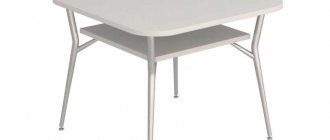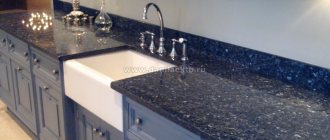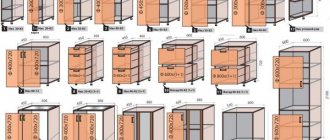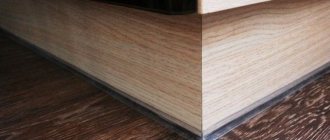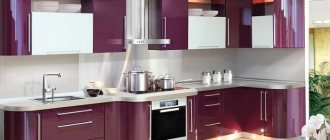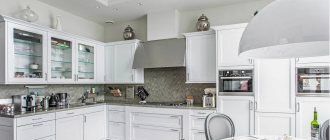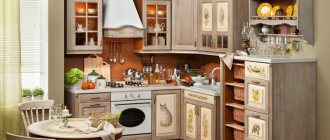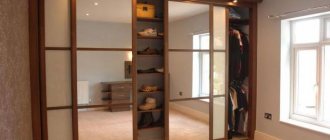The kitchen is the most important place in any home! It, like a magnet, attracts household members, reflects the habits, character traits, and material well-being of its owners. This is where you can escape from pressing problems and gather the whole family around the big table.
It is very important not only to equip this room, but also to plan it correctly. The main criteria that should be followed when organizing a kitchen space are convenience and versatility. When planning a kitchen, the main thing is to rationally distribute every centimeter so that while cooking you don’t have to bend over or reach for something. That’s why when buying kitchen furniture you should take into account not only the material and color scheme, but also its dimensions.
There is no specific answer to the question of what the acceptable height of a kitchen set should be. There are kitchens made both according to the dimensions indicated in GOST, and models whose dimensions are selected individually. Let's find out what the Antares store specialists think about this.
How tall are kitchens made?
Before ordering furniture for the kitchen, it is important to consider the size and design features of the room. Companies that manufacture furniture most often focus on statistics and produce kitchen sets of standard dimensions. Based on this, the level of the tabletop ranges from 860-900 mm. For people with a height of 158 cm to 172 cm, this is quite enough.
If the height of the owners differs significantly, they think about an individual project. Then the furniture is made taking into account the client’s wishes and fits into non-standard or small-sized rooms.
To make it easy and pleasant to work at the work surface, its height should be slightly below waist level. The dimensions of kitchen furniture are determined taking into account the height of the person who usually prepares food for the family. It is not difficult to calculate the optimal countertop height in the kitchen:
- you need to stand with your back straight;
- bend your arm at the elbow;
- the acceptable height of the working plane will be 3-4 cm below the elbow;
- It is advisable to place the hob 5-6 cm below the elbow so that splashes of hot oil do not get directly into the face;
- For working with dough and kneading products, it is better to choose low-level surfaces. Because during these processes you need to apply physical force, it will be easier to do this if the movements are directed from top to bottom.
An important characteristic is the location of communications.
When choosing the type of lockers, the family's lifestyle is taken into account. If the housewife often cooks, a large work area is required. Otherwise, it is more advisable to order more wall shelves and models with drawers.
First, a sketch of the placement of objects is created. Drawings are created for each cabinet, taking into account niches and projections in the walls.
Next, you need to decide on the performer. The term “non-standard sizes” is conditional. Each manufacturer has its own size restrictions. Before developing the final version, it is necessary to find out exactly what the maximum and minimum parameters are for a particular manufacturer. If you have a website, non-standard and standard sizes of furniture fronts for the kitchen can be found via the Internet.
Work surface with different levels
Consumers are increasingly choosing multi-level countertops. It is not only beautiful and convenient, but also very practical:
- during long cooking, the housewife does not feel tired, since the muscles of the buttocks, arms, and back experience insignificant tension;
- the working surface is divided into several functional zones, which greatly simplifies cleaning;
- You can harmoniously and practically play around with a non-standard shaped room, increasing the usable space, integrating surfaces into niches or free corners, behind which it is convenient and comfortable to work.
The upper tier is positioned so that you can reach the second shelf without standing on your toes. It is important to take into account the distance from the lower tier to the cabinets located above. It should be at least 450 mm, which will allow you to arrange household appliances and kitchen appliances with utmost convenience. The acceptable distance between the floor and hanging tiers is 550-600 mm, taking into account the fact that the kitchen will be used by people of average height.
Standard sizes
The standard sizes of kitchen furniture are as follows:
- 60x30x80 cm for large wall cabinets and 60x30x40 cm for small ones;
- The corner module has a trapezoid shape with sides of 60, 31.5 and 38 cm.
- 60x60x80 cm for a two-door base cabinet and 50x60x80 cm for a single-door cabinet;
- the minimum distance from the top cabinet to the countertop is 45 cm;
For convenient storage of kitchen accessories, food, containers and household appliances, 6-10 standard cabinets are enough for a family of three.
What height should I make cabinets in the kitchen?
It is impossible to imagine a kitchen set without wall cabinets. They are convenient for storing dishes, cans of cereals, and other accessories and devices. The load on the upper modules is large; you not only need to ensure reliable fastening, but also figure out at what height to hang the furniture.
Specialists at the Antares store advise installing cabinets in such a way that their top edge is no more than 250 mm higher than a person’s height:
- for people about 175 cm tall, the lower shelves of the cabinet are located at a level of 1 m 50 cm from the floor;
- tall people will be comfortable using cabinets located at a height of 1 m 80 cm.
If you do not follow these rules, then you will only be able to reach the top shelves with the help of a stool. It is important to take into account not only the height, but also the age of the people who will use the kitchen set. For an elderly person, it is better to choose wall cabinets of medium height; they are also not hung high, then there will be no need to climb a ladder or stepladder, which can cause injuries.
Since the shelves located at the top are difficult to reach, they are not used often. This space is best used for storing light items.
Before determining the level for the furniture canopy, it is advisable to take into account the following nuances:
- the height of all people living in the apartment;
- height of suspended modules;
- the distance between the tabletop and the top tier;
- ceiling height;
- filling of hanging modules.
If the cabinets are placed at eye level, this will allow you to reach the desired shelf without making significant effort. It is also important to consider the location of ventilation ducts; furniture should not block access to them.
The standard height of wall cabinets is 70-90 cm. This parameter determines how functional the kitchen furniture will be. When designing a kitchen, we take into account what will be stored in the upper tier. Often, small kitchens have tall cabinets to provide more additional shelves for storage. However, you need to ensure that there is no visual overload. Too tall cabinets will make the kitchen cramped and less cozy.
A kitchen set with an upper tier reaching to the ceiling is not installed in rooms whose height is higher than 3 m. Such a design will look unnatural, and it is almost impossible to use the shelves located at the top without the help of a stepladder.
It is customary to leave 30-40 cm of free space above the hanging modules. This is done not only for aesthetic reasons, but also for practical purposes. This gap is used for air ducting, as well as to get rid of clutter and hide annoying wires (for example, from a range hood).
In those areas where large household appliances are located, the height of the cabinets may be smaller, but not less than 36-40 cm. At the request of the customer, the height of the upper tier is increased, sometimes it can reach up to 120 cm. The most important thing is that the housewife can freely reach to the bottom edge of the upper modules.
Corner models
Typical cabinet sizes:
- height 85 cm;
- width 24-80 cm;
- depth 40-80 cm.
They are:
- floor;
- hanging.
The calculations differ little from those used for direct models. The only exception is an increase in the distance between the doors by 1-2 mm.
What to do with built-in appliances
It is not recommended to install household appliances inside wall cabinets, so their depth is approximately half that of the lower tier. If, however, a decision is made to hide a microwave or oven inside the module, then the depth of the cabinets should be at least 40 cm. Under this condition, the appliances can be used without difficulty. In order for the equipment to cool faster and to avoid a fire hazard, the back wall of the cabinet is removed.
Sometimes the hood has to be built into a wall-mounted module, then you need to take into account the type of connection of the stove. If it is an electric oven, the hood is placed at a distance of 70-75 cm and 75-80 cm - in the case when a gas hob is used.
In order for the kitchen set to look like a single whole, the width of the fronts of the top and bottom rows must match. There is no need to make the facade too wide, because when opened it will take up a lot of space. The standard width of the facade of one kitchen door is 30-50 cm, two – 60-100 cm.
Distance between kitchen furniture facades
For swing doors, the height is 3 mm less than that of the body, the width is 4 mm. The widths of the boxes are the same. In height, 3 mm is subtracted from the frame parameter. The parameters for the upper cabinets, which open vertically, are the same.
Indentations when installing facades
In tall cabinets for built-in appliances, it is important to take into account the gaps specified by the appliance manufacturer. For the refrigerator it is 4-5 mm, above the oven 5-7 mm. Sometimes sticks are mounted above microwave ovens; its thickness must be taken into account.
Gaps when installing a refrigerator
Correct installation of the oven
Hob installation parameters
Working surface height
The generally accepted height of floor modules is 850 mm. However, this indicator can be adjusted if you install twist-out legs on the furniture. But most often they choose a standard base. For people whose height does not exceed 178 cm, a support with a level of 100-120 mm is suitable, then the total height of the bottom row will be 800-850 mm, working behind such a surface is pleasant and comfortable.
For a person above average height, select a base with a level of 150-200 mm, then the working surface will be at a level of 900-950 mm. For people with disabilities or those whose height is up to 150 cm, the suitable working surface height is 760 mm.
The level of the lower tier is calculated based on the following indicators:
- depth of the working area (600-700 mm). The larger it is, the wider the viewing angle and the more pleasant it is to be in the kitchen;
- the distance between the lower and upper tier. It is important to position the upper modules in such a way that you do not hit your head on them during operation;
- the optimal gap between the hob and the sink is at least 400 mm. This will prevent splashes of water and detergent from getting into the soup pot.
Keep in mind that the height of the working surface is also affected by the thickness of the table top (usually it is 3-4 cm). The table top reaches the kitchen apron; the joint is masked using a wall edge or kitchen plinth. A free space of several centimeters is left between the cabinets and the wall, which is used for laying gas and water pipes, masking wires, etc.
Bottom row
The typical depth of the bottom row cabinets is 60 cm, the thickness of the countertops is 3-5 cm, less often 6 cm.
When calculating the height of the doors, subtract:
- 1 cm (distance to floor);
- tabletop thickness;
- gaps (from the table top to the door 1-3 mm, between the doors 3 mm).
If the doors are double, the distance between the facades is 3 mm. If there is a drip collector in the countertop, the distance to the door is 4-5 mm.
If the row is too wide, you can insert elements for containers with spices or bottles into the free space.
Depth of the working area in the kitchen
Recommended tabletop depth is 600 mm. This size will allow you to easily integrate “essentials” (sink, hob, etc.). The minimum depth of drawers is 460 mm, optimal is 560-580 mm.
If the size of the room allows, the depth of the working surface can be increased to 900 mm. Then the depth of the drawers is at least 760 mm. In professional kitchens, as well as in loft-style rooms, worktops with a depth of 1200 mm look good. Such a large surface is best installed in the center of the kitchen. This is a multifunctional table (also called an island) that increases the comfort of the kitchen and allows you to conveniently move to other workspaces.
To select the ideal depth of the working area, it is necessary to take into account the length of the arms of the person who most often prepares food in the family, as well as the dimensions of built-in appliances and tabletop household appliances.
Table top 1200 mm
Models of this size are used extremely rarely for domestic needs, since even in a spacious kitchen they will look quite cumbersome. Typically, slabs with a width of 1200 mm are used in industrial kitchens, where multi-stage food processing takes place and an appropriate area is required.
The price of wide countertops is disproportionately higher than narrow counterparts. Convenient use of all the benefits of free space inside the box is possible only with double-sided access. Therefore, in home kitchens they are found either on dining tables or as the surface of a central element (an island table).
Built-in technology
The tendency to tie the oven to the hob is gradually becoming a thing of the past. Increasingly, this technique is being integrated at the torso level. The housewife does not need to bend low to the floor every time to check the readiness of the dish, and this is also very convenient from a safety point of view. Burns and injuries occur much less frequently.
Sometimes a washing machine is built under the countertop. Since the standard height of appliances is 850 mm, it is often necessary to increase the level of the lower base of the kitchen unit to 900-910 mm. This can be done using adjustable furniture legs or by replacing the standard 100 mm plinth with a 150 mm one. Based on this, it is worth considering that the upper modules will also rise.
It is customary to build a dishwasher into the bottom row. Its standard dimensions are 55 cm/60 cm/82 cm, so it fits under the tabletop without any problems.
Kitchen cabinet doors, dimensions
Most often, doors are made from:
- laminated, veneered, PVC or acrylic-coated chipboard;
- laminated with PVC, acrylic, veneered, trimmed with plastic panels or photo printed MDF;
- array;
- glass in an aluminum frame.
Since the size of the doors differs little from the size of the body, you should not make too large facades from solid wood. Large glass elements are also not desirable. It is also important to take into account the door span of 40-50 cm. Not all manufacturers produce doors made of solid wood and MDF with glass. This also needs to be clarified with the specific manufacturer.
What you need to know about curved facades
A modern solution is considered to be radius facades, curved inward or outward. Separate height parameters have been developed for them (cm):
- 53,6;
- 57,3;
- 71,6;
- 95,6;
- 131,6.
The width corresponds to that of traditional cabinets.
When choosing radial doors, it is also advisable to clarify whether they are manufactured in the selected workshop.
Typically, furniture of non-standard sizes is required for a kitchen with an atypical shape. The space needs to be used rationally; standard furniture does not allow this. You can try to develop sketches yourself. However, it is not easy to ensure that the filling is comfortable and functional, everything fits perfectly to the walls. It makes sense to think through furniture drawings yourself only if you yourself will manufacture the cabinets and facades.
In fact, the headset project is complex; development requires special knowledge. There are nuances that a non-professional cannot take into account. If the design is incorrect, the new furniture will not bring joy. It turns out that money and time were wasted.
If you have a limited budget, it is more profitable to stick to standard parameters. Changes should only be made in special cases. This may be the non-standard height of the housewife, the inconvenient shape of the kitchen, the presence of niches or protrusions on the walls. It is important to take into account all factors, features and rules. The standard sizes of kitchen facades were developed for good reason. In special situations, it is also not worth designing all items according to non-standard sizes. This will reduce the final cost.
